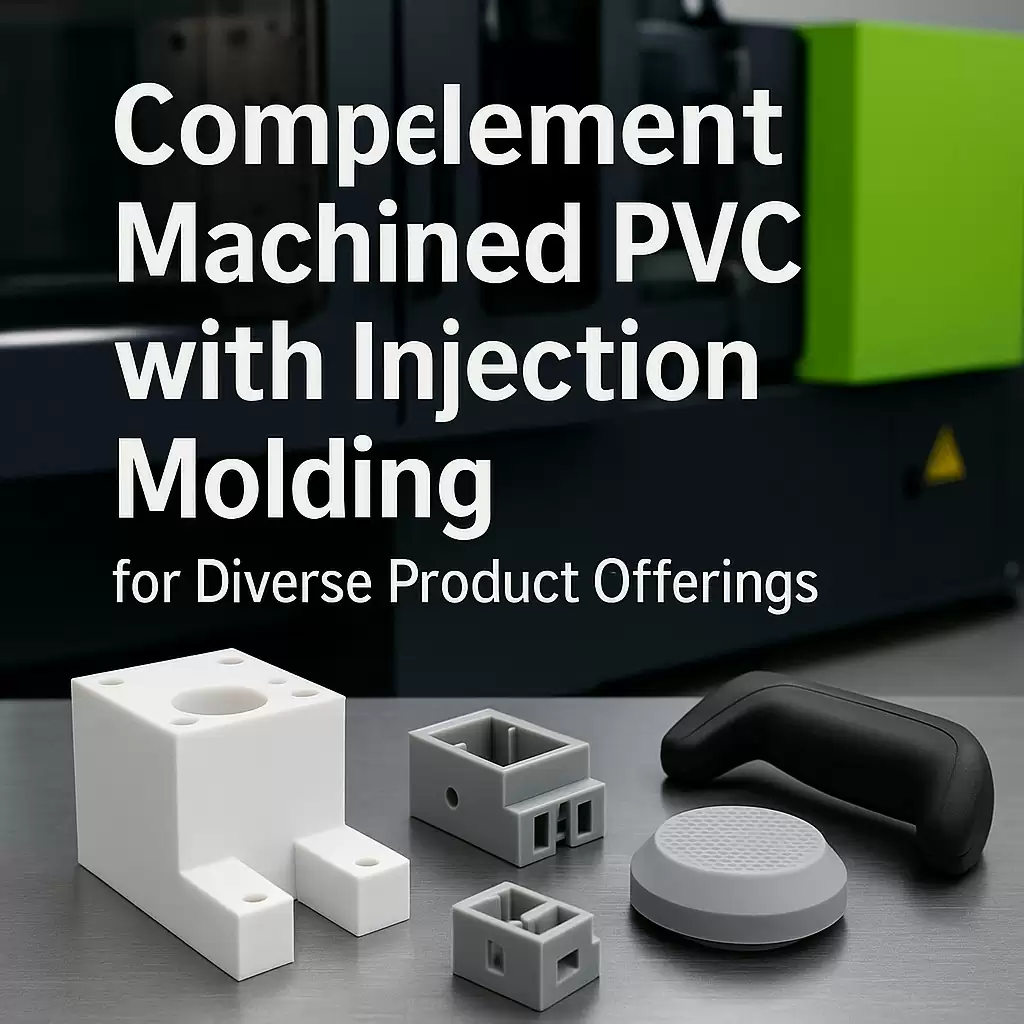Complement Machined PVC with Injection Molding to Broaden Your Product Portfolio
Complement Machined PVC with Injection Molding to Broaden Your Product Portfolio
Polyvinyl chloride (PVC) is one of the most adaptable thermoplastics on the market. Rigid PVC offers high modulus, chemical resistance, and excellent dielectric properties, while flexible grades deliver rubber-like softness with superior clarity. Because PVC can be both injection-molded and machined from solid stock, savvy product teams often combine the two methods to balance speed, cost, and design freedom—especially when product lines range from quick-turn prototypes to high-volume components.
1 Why Pair Machining with PVC Injection Molding?
| Decision Driver | Machined PVC | Injection-Molded PVC |
|---|---|---|
| MOQ / Lead Time | 1-off to 500 pcs ⟶ parts in < 48 h | 5 000 + pcs ⟶ parts in 3-5 weeks |
| Up-Front Tooling Cost | None (CNC programs & fixtures) | US $4 k–20 k for aluminum or steel molds |
| Complex Internal Features | Deep pockets, undercuts via 5-axis | Slides, lifters, or two-shot over-molding |
| Tight Tolerance / Flatness | ±0.025 mm achievable after anneal | ±0.05–0.1 mm typical CpK ≥ 1.33 |
| Per-Part Cost @10 k pcs | High (machining time dominates) | 70–90 % lower after tooling amortized |
Takeaway: Machine PVC when volumes are low, design is still in flux, or features demand subtractive accuracy; shift to molding once geometry freezes and unit cost rules.
2 Material Guide—Rigid vs. Flexible PVC
| Grade | Hardness / Shore | Key Attributes | Best Processes |
|---|---|---|---|
| Rigid (“uPVC”) | R 112-120 | High stiffness, flame-retardant (UL V-0) | CNC, injection, extrusion |
| Impact-Modified PVC | R 90-100 | Improved Izod, −40 °C cold crack | Injection, machining for inserts |
| Flexible PVC | A 55-85 | Bend radius < 5 mm, good clarity | Over-molding, extrusion, dip molding |
| Medical / DEHP-Free | A 65-80 | USP VI, gamma-stable | Clean-room molding, tube extrusion |
3 Hybrid Design Strategies
-
Prototype-to-Production
CNC machine short-run pilot housings; validate fit, function, and chemical resistance → convert to multi-cavity mold for mass production. -
Insert-Molded Assemblies
Machine load-bearing uPVC brackets, then over-mold with flexible PVC gaskets for IP 67 sealing—one SKU, two processes, zero secondary assembly. -
Post-Machined Bosses & Threads
Mold bulk geometry in a low-cost aluminum tool; finish-machine tight-tolerance threads or sealing faces only where needed.
4 Processing Tips—Getting PVC Right First Time
| Challenge | Machining Fix | Molding Fix |
|---|---|---|
| Residual Stress / Warpage | Anneal billets at 60 °C for 2 h before roughing | Maintain mold temp 60–70 °C; slow cooling |
| Tool Gumming | Use sharp carbide, 4-flute finishing end-mills; light climb cuts | Thorough resin drying (if flexible grade) to avoid hydrolysis |
| Burn Marks | Air blast cooling; do not use cutting oil that contains aromatics | Screw RPM < 100 r/min; vent grooves 0.013 mm |
| Surface Finish | Finish pass 0.05 mm at 6 000 rpm; buff with non-abrasive wheel | SPI-A2 polish for optical; VDI 27 texture to hide flow lines |
5 Typical Cross-Process Applications
| Market | Machined PVC Parts | Molded PVC Parts |
|---|---|---|
| Industrial Fluid-Handling | Custom valve blocks, manifolds | Over-molded diaphragms, quick-connect seals |
| Electrical & Telecom | Precision dielectric spacers | UL V-0 cable glands, connector boots |
| Medical & Lab | Prototype flow cells, fixture nests | Flexible tube fittings, drip-chamber housings |
| Consumer Products | Short-run fascia, mounting plates | High-volume splash-proof enclosures |
6 Scale-Up Pathway with TaiwanMoldMaker.com
| Milestone | Our Integrated Service |
|---|---|
| Rapid CNC Prototype | 3-axis & 5-axis machining from uPVC plate in < 72 h |
| 48-Hour PVC DFM Pack | Gate plan, Moldflow®, draft & sink analysis, material spec |
| Bridge Tooling | Aluminum mold → 500–5 000 shots while demand ramps |
| Steel Multi-Cavity | H13 hot-runner, valve-gated tool for 100 k + shots/year |
| Inline Finishing | Ultrasonic welding, pad printing, over-molding flexible PVC gaskets |
Quick links:
• Custom Mold and Design Maker
• Mold Service
• Injection Mold
• Molding
• Customer Examples
7 Next Steps—Blend the Best of Both Worlds
-
Upload your CAD & annual volume tiers (prototype / pilot / mass).
-
Receive a machining vs. molding ROI model within 48 hours.
-
Kick off prototypes via CNC while aluminum tooling is cut.
-
Lock steel molds once demand is proven—and watch per-unit cost plunge.
Machining + injection molding = agility now, efficiency later. Let TaiwanMoldMaker.com orchestrate both under one quality system, so you launch diverse PVC product lines faster and at the right cost curve—every time.









